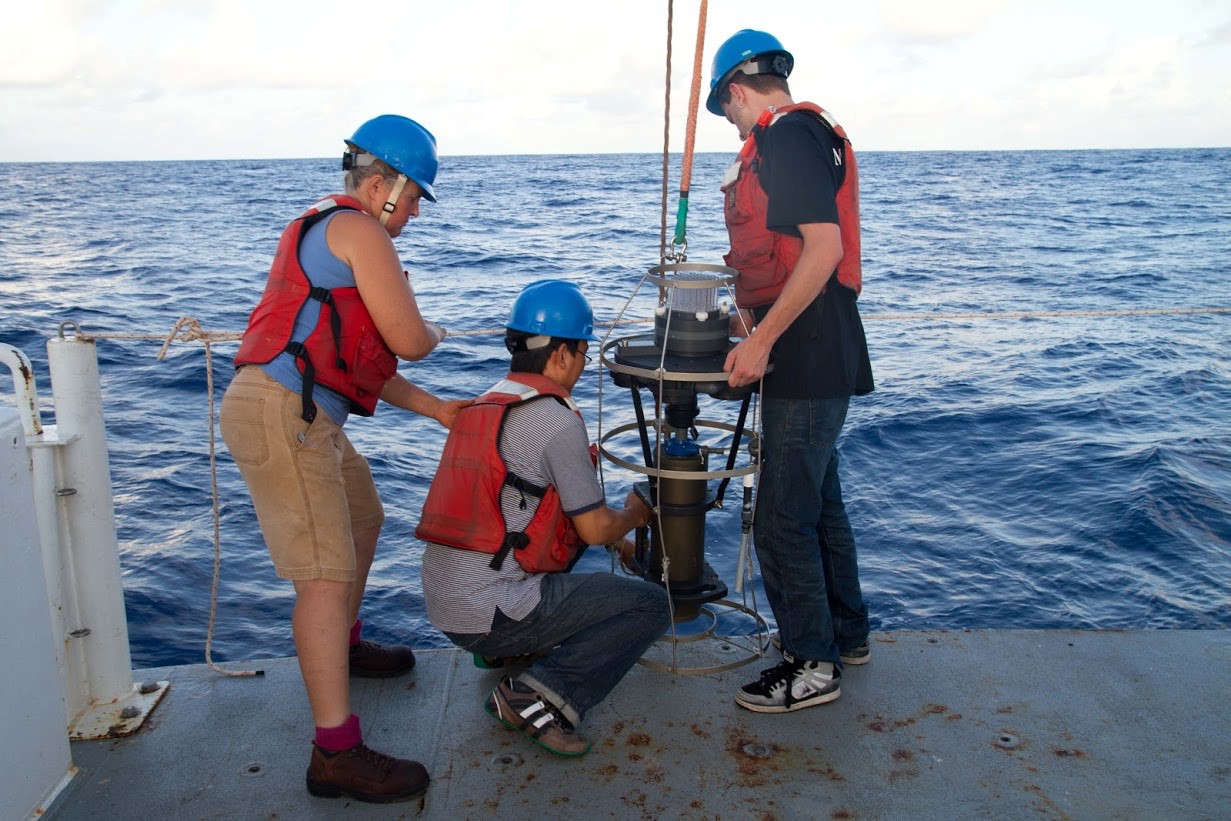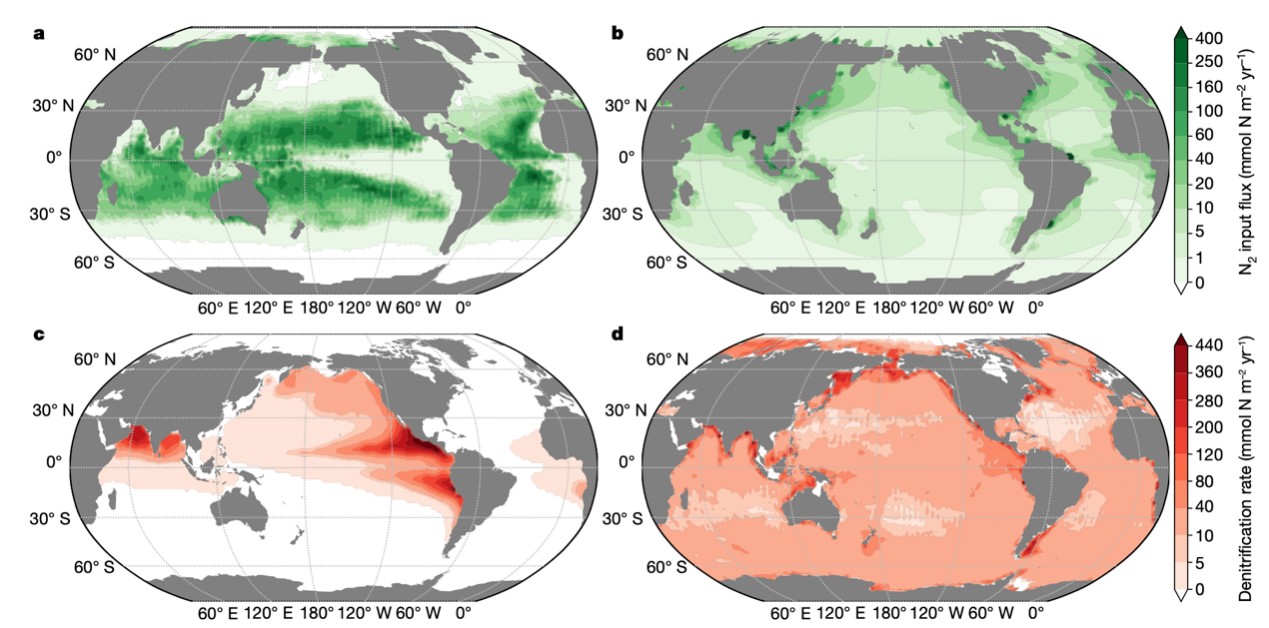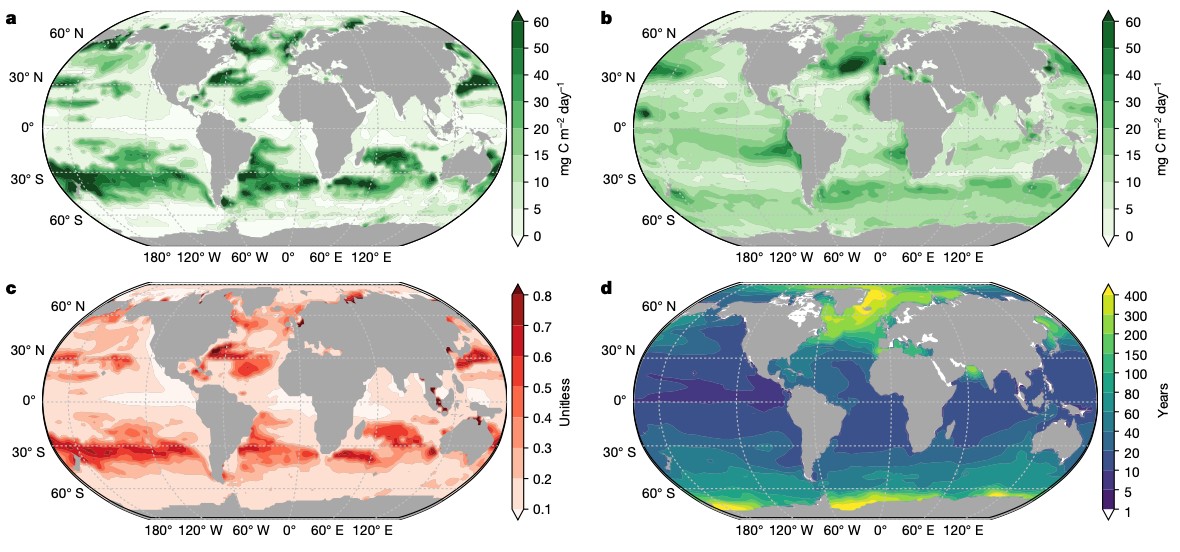观测是人类认识和经略海洋最直接且基础的研究手段。在求学期间,王为磊的科考足迹就已遍布黄海、东海和南海,他还前后5次前往百慕大海域参加科学考察(图1),累计在海上作业超过300天。这些丰富的野外科考经历,使他深刻体会到地图上每一个数据点的珍贵和来之不易。多年来,王为磊一直在深入思考和积极探索,如何更有效地挖掘和利用前人积累的观测数据,以实现在海洋领域科学认知上的新突破。

图1、王为磊博士(中)在百慕大海区布防大体积采样泵
海洋观测为我们研究海洋提供了第一手资料,然而,受时间和空间的双重限制,观测往往难以全面捕捉海洋复杂多变的动态过程。另外,广袤无垠的海洋也使得现场观测的范围相对有限。海洋模型的开发则打破了时空限制,为我们提供了对全球或区域海洋进行多维度预估预报的可能性。但受限于当前模型的发展水平或观测数据时空分布的代表性,模型与观测之间往往存在显著差异。
作为一位逆向模型工作者,王为磊致力于弥合观测和模型之间的差异,搭建模型与观测间的桥梁。得益于在现场观测和模型开发方面的丰富经验,在过去的十余年里,王为磊以海洋逆向模型为主要工具,以海洋碳、氮的生物地球化学循环为主要研究内容,取得了若干重要的科学突破:
1、海洋氮循环:原创性地构建了三维磷-氮耦合的逆模型(BGCIMv0),在全球尺度上刻画了海洋氮源、汇过程通量分布格局;揭示了固氮和脱氮(反硝化/厌氧氨氧化)的空间分异以及浮游动物摄食对固氮的抑制作用,精确量化了输出有机物中氮磷化学计量比的空间变率,显著提升了对海洋氮生物地球化学循环的认识(图2)。

图2、a)固氮速率、b)大气沉降和河流输入、c)水体低氧区反硝化和d)沉积物反硝化速率的分布(Wang et al., 2019 Nature)
2、海洋生物泵:原创性地构建了三维磷-碳-氧耦合的逆模型(BGCIMv1),反演了涵盖多过程驱动的全球海洋生物泵通量,调和了总碳输出和深层海洋呼吸作用的碳需求之间的矛盾,并从封存时间的角度量化了生物泵通量(图3),研究成果入选“2023年度中国海洋与湖沼十大科技进展 ”。

图3、a)活性有机碳和b)半活性有机碳的输出通量;c) 溶解有机碳输出占总碳输出的比例;d)活性有机碳在不同海区输出后的滞留时间(Wang et al., 2023 Nature)
3、海洋负排放和气候反馈:建立了一套具有月度分辨率的表层二甲基硫(DMS)分布和通量的数据库,为海洋源DMS与气候系统的负反馈关系提供了关键证据;系统性地评估了营养盐加富和大型海藻养殖的增汇效率和生态效应,提升了气候与海洋互馈作用的认识。
王为磊目前的工作重点包括三个方面:
1、大尺度生物地球化学循环:使用三维逆向反演模型研究碳与营养盐的生物地球化学循环;
2、沉降颗粒动力学:使用逆向反演模型耦合多种示踪剂约束颗粒聚合与解聚速率常数,研究颗粒间相互作用如何影响海洋碳汇;
3、痕量气体的生物地球化学循环:使用原位测量数据和机器学习研究二甲基硫(DMS)、氧化亚氮(N2O)和甲烷(CH4)等痕量气体的生物地球化学循环。
如有兴趣了解王为磊博士的更多情况,欢迎访问其个人主页:https://mel2.xmu.edu.cn/faculty/WeileiWang/,或联系Wei-Lei.wang@xmu.edu.cn。
王为磊博士于2021年3月加盟91看自拍海洋与地球学院并成为91看自拍的固定科研人员,现任海洋化学与地球化学系教授。他于2015年获得美国纽约州立大学石溪分校的博士学位,在美国加利福尼亚大学尔湾分校从事博士后研究,回国前在美国加利福尼亚大学尔湾分校学担任助理项目科学家。近5年以第一或通讯作者在Nature(2篇研究论文)、 Nature Communications等国际顶尖或权威期刊发表论文20余篇,担任西北太平洋海洋环流与气候试验(NPOCE)计划科学指导委员会委员和中国海洋研究科学委员会(SCOR)青年委员。 |
Dr. Wei-Lei Wang: Dedicated to bridging the gap between ocean observation and modeling
Observation is the most direct and fundamental means for human beings to understand and manage the ocean. During his academic career, Dr. Wang Wei-Lei's research expeditions have covered the Yellow Sea, East China Sea, and South China Sea, and he has embarked on five research expeditions to the Bermuda region (see Figure 1), accumulating over 300 days of fieldwork at sea. These extensive fieldwork experiences have deeply impressed upon him the value and difficulty of each data point on the map. Over the years, Dr. Wang Wei-Lei has been deeply pondering and actively exploring how to more effectively utilize and unearth the accumulated data from predecessors to achieve new breakthroughs in scientific cognition.
Due to limitations in time and space, observations often struggle to comprehensively capture the complex and dynamic processes of the ocean. Additionally, for the vast and expansive oceans, the scope of field observations is relatively limited. Therefore, the emergence of ocean models provides us with the possibility to overcome these limitations. These models can offer multidimensional estimations and forecasts for global or regional oceans. However, due to the limitations in human understanding of the ocean, model parameterizations often lead to errors. Moreover, observational data often cannot fully represent spatiotemporal distributions, resulting in significant discrepancies between models and observations.
Inverse modelers strive to bridge the gap between observations and models, establishing connections between the two and seeking the truth between observation and model. Dr. Wang Wei-Lei, benefiting from his extensive experience in field observations and model development, has focused on ocean inverse modeling for over a decade, with a primary focus on the biogeochemical cycles of ocean carbon and nitrogen. Through his work, he has achieved a series of significant scientific breakthroughs.
1. Marine Nitrogen Cycling: Dr. Wang developed a three-dimensional phosphorus-nitrogen coupled inverse model (BGCIMv0), which delineated the global-scale distribution patterns of nitrogen sources and sinks in the ocean. Dr. Wang’s work revealed spatial decoupling of nitrogen fixation and denitrification/anammox processes, as well as the inhibitory effect of zooplankton grazing on nitrogen fixation. Furthermore, his work accurately quantified the spatial variability of the nitrogen-to-phosphorus stoichiometric ratio in organic matter output, significantly enhanced our understanding of marine nitrogen biogeochemical cycles (see Figure 2).
2. Marine Biological Pump: Dr. Wang developed an three-dimensional phosphorus-carbon-oxygen coupled inverse model (BGCIMv1), which successfully derived the global oceanic biological pump fluxes driven by multiple processes. His work reconciled the contradiction between total carbon output and carbon demand for deep ocean respiration. Additionally, his work quantified the fluxes of the biological pump from the perspective of sequestration time (see Figure 3).
3. Ocean Negative Emissions and Climate Feedback: Dr. Wang’s established a database of surface dimethyl sulfide (DMS) distribution and fluxes with monthly resolution. Dr. Wang’s work provided crucial evidence for the negative feedback relationship between oceanic DMS sources and the climate system. Additionally, he conducted a systematic evaluation of the efficacy and ecological effects of nutrient enrichment and large-scale seaweed cultivation for carbon sequestration. His work enhanced our understanding of the climate-ocean feedback interactions.
Dr. Wang Wei-Lei's current work focuses on three main aspects: a) Large-Scale Biogeochemical Cycles: Using a three-dimensional inverse modeling approach to study the biogeochemical cycles of carbon and nutrients. b) Particle Dynamics of Sedimentation: Employing inverse modeling coupled with multiple tracers to constrain particle aggregation and disaggregation rate constants, investigating how interactions between particles affect the oceanic carbon sink. c) Biogeochemical Cycling of Trace Gases: Using in-situ measurement data and machine learning techniques to study the biogeochemical cycling of trace gases such as dimethyl sulfide (DMS), nitrous oxide (N2O), and methane (CH4).
For more information, please visit Dr. Wei-Lei Wang’s website https://mel2.xmu.edu.cn/faculty/WeileiWang/ or contact him at weilei.wang@xmu.edu.cn
Dr. Wang Wei-Lei joined the College of Ocean and Earth Sciences at Xiamen University and became a member of the State Key Laboratory of Marine Environmental Science in March 2021. He is currently a professor in the Department of Marine Chemistry. Dr. Wang obtained his doctoral degree from the SUNY Stony Brook University in 2015. He conducted postdoctoral research and was promoted to an assistant project scientist position at the University of California, Irvine, before returning to China. Over the past five years, he has published more than 20 papers as the first or corresponding author in top international journals such as Nature (two research articles) and Nature Communications. He also serves as a member of the Scientific Steering Committee for the Northwest Pacific Ocean Circulation and Climate Experiment (NPOCE) and as a youth member of the Scientific Committee on Oceanic Research (SCOR) of China. |